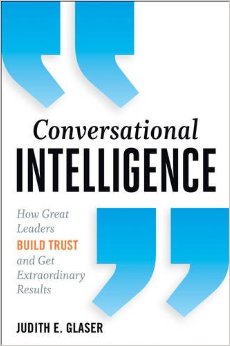Conversational Intelligence
Glaser, Judith. (2014). Conversational Intelligence. Brookline, MA: Bibliomotion, Inc.
An opening quote, Buckminster Fuller, in the introduction sets the tone for this book. “You never change things by fighting the existing reality. To change something, build a new model that makes the existing model obsolete.” This is the essence of continuous progress.
What I have learned in over 40 years in education is this: “If it isn’t working, try something else.” As Einstein said years ago, continuing to do what isn’t working is insanity. Judith Glaser provides some useful graphics to help our conversations be more productive. For example, on page 159 there is a chart titled Trust Changes Reality that outlines brain functions that increases or decreases trust. The connection to current brain research strengthens her application to build constructive results.
One of the points that registered with me is Glaser’s Tell – Sell – Yell Syndrome. Yes, telling is easier and, from my experience, is short term at best. If tell doesn’t work, we try to sell people on an idea. Finally, when selling (sometimes manipulation) isn’t helpful people start yelling. Yelling gives the impression that we can force conformance. We know from multiple sources (Pink, Deci, Ryan, Amabile, etc) that threat and fear get short term compliance and is not conducive to long term knowledge work. This helps me discern the mode in which the other person is operating.
Glaser gives a matrix with three different kinds of conversations. Level 1 is transactional, asking and telling that exchanges information. Level II is positional- advocating and inquiring strategies that explore others’ ideas that is an exchange of power. And, Level III, is characterized as transformational – using share and discover as the interaction resulting in exchanging energy. As we all know, depending on the desired outcome, you may need all three in your repertoire.
Expanding on brain research, most of us know about the reptilian, limbic, and neocortex parts of the brain and their functions. Glaser expands this view to five parts of the brain, adding the heart/brain and the prefrontal cortex (executive function). This pushed my thinking to see people in more ways than only in a survival, emotional, and/or thinking mode. This may give you another perspective to consider as well.
As many authors and researchers before have noted, trust is a foundational attitude for learning in Glaser’s view. The protocols and graphics included in Glaser’s book are well worth the investment—both in buying the book and time spent developing skills in becoming more Conversationally Intelligent.

